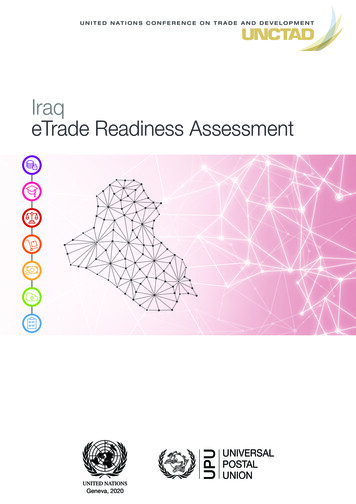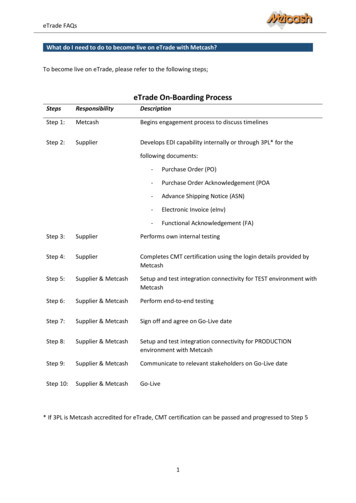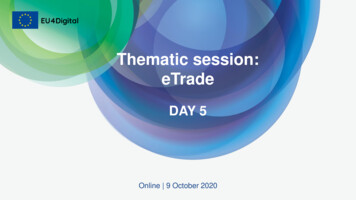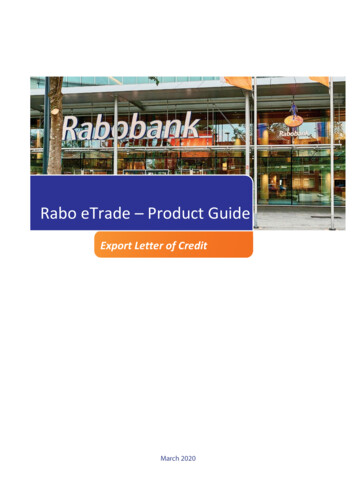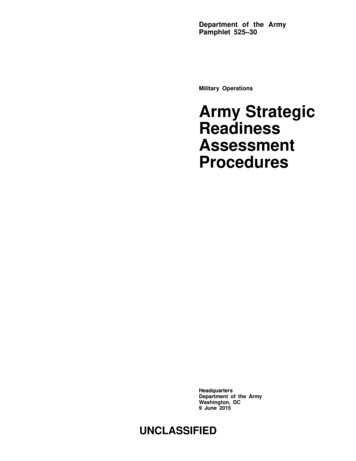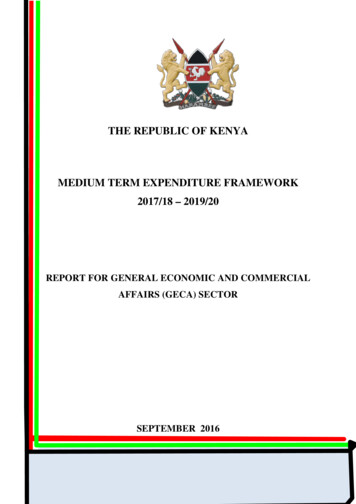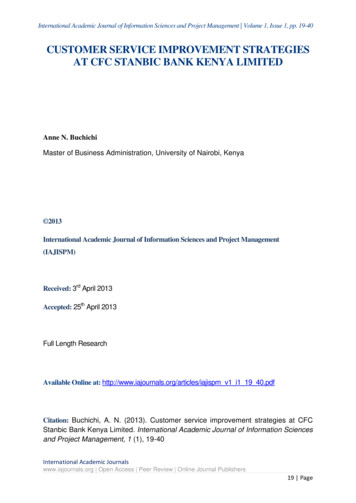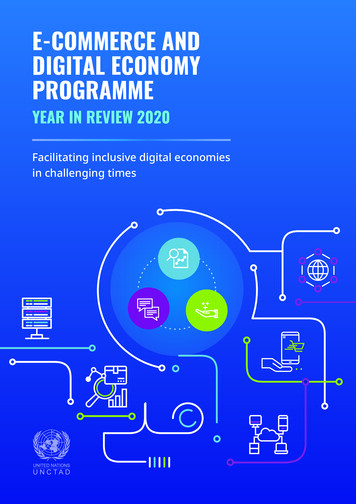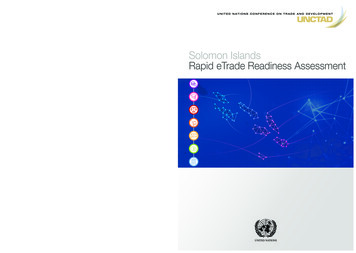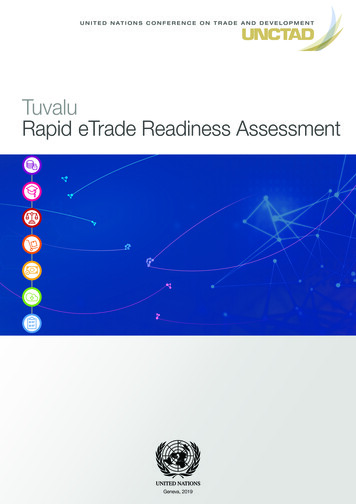![Kenya: ETrade Readiness Assessment [ADVANCE COPY]](/img/24/dtlecdc2022d2-en.jpg)
Transcription
U N I T E D N AT I O N S C O N F E R E N C E O N T R A D E A N D D E V E L O P M E N TKenyaeTrade Readiness AssessmentAdvance copyGeneva, 2022
II 2022, United NationsAll rights reserved worldwideRequests to reproduce excerpts or to photocopy should be addressed to the Copyright Clearance Center atcopyright.com.All other queries on rights and licences, including subsidiary rights, should be addressed to:United Nations Publications405 East 42nd StreetNew York, New York 10017United States of AmericaEmail: publications@un.orgWebsite: https://shop.un.org/The designations employed and the presentation of material on any map in this work do not imply theexpression of any opinion whatsoever on the part of the United Nations concerning the legal status of anycountry, territory, city or area or of its authorities, or concerning the delimitation of its frontiers or boundaries.Mention of any firm or licensed process does not imply the endorsement of the United Nations.This publication has been edited externally.United Nations publication issued by the United Nations Conference on Trade and DevelopmentUNCTAD/DTL/ECDE/2022/2 (Advance copy)ISBN: 978-92-1-113058-4eISBN: 978-92-1-001863-0Sales No. E.22.II.D.29This report was developed with the technical and financial support of the Deutsche Gesellschaft fürInternationale Zusammenarbeit (GIZ) on behalf of the German Federal Ministry for Economic Cooperation andDevelopment (BMZ) and technical inputs from the British Standards Institution (BSI).
NOTEIII
Kenya eTrade Readiness AssessmentIVPREFACEThe eTrade for all initiative, launched at the fourteenth session of the United Nations Conference on Trade andDevelopment (UNCTAD XIV) in July 2016, is a practical example of how to harness the digital economy in supportof the 2030 Agenda for Sustainable Development, notably Sustainable Development Goals 5, 8, 9 and 17. Theinitiative seeks to raise awareness, enhance synergies, and increase the scale of existing and new efforts bythe development community to strengthen the ability of developing countries to engage in and benefit frome-commerce, by addressing seven relevant policy areas: E-commerce readiness assessment and strategy formulation ICT infrastructure and services Trade logistics and trade facilitation Payment solutions Legal and regulatory frameworks E-commerce skills development Access to financingAs part of the initiative, demand-driven assessments are envisaged to provide a basic analysis of the currente-commerce situation in the countries concerned, and to identify opportunities and barriers. The resulting reportswill serve as valuable inputs to these countries’ involvement in various discussions related to e-commerce anddigital trade, such as in the context of the UNCTAD Intergovernmental Group of Experts on E-commerce andthe Digital Economy.It may further help developing countries and least developed countries (LDCs) to identify areas in which theycould benefit from assistance by partners of eTrade for all.The Kenya eTrade Readiness Assessment is the fifth assessment conducted by UNCTAD in a non LDC country,and follows an enhanced methodology. As per this methodology, surveys were disseminated as part of the datacollection effort. In Kenya, they targeted respondents in three distinct groups – public sector, private sectorand consumers. Through collaboration with the British Standards Institution (BSI), an eTrade for all partner, thesurveys were enriched to investigate the role of standards in e-commerce development. The assessment addsto the 31 assessments conducted by UNCTAD since 2017. The eTrade Readiness Assessment for Kenya wasconducted during a period when the coronavirus disease (COVID-19) pandemic was ongoing, and it is reflectedin some of the findings of the report. The enduring economic and social impacts of the pandemic make it evenmore important for policymakers and other stakeholders to join forces to take actions aimed at addressing thee-commerce situations. With the eTrade for all partners, UNCTAD is committed to supporting Kenya in its resolveto harness the potential of e-commerce for development.Shamika N. SirimanneDirector, Division on Technology and Logistics, UNCTAD
ACKNOWLEDGEMENTSVACKNOWLEDGEMENTSThis eTrade Readiness Assessment for Kenya was prepared by Dr. Monica Kerrets-Makau, (ThunderbirdAcademic Director, Africa Center of Excellence, Nairobi) UNCTAD lead consultant. Ms. Josephine Towett,UNCTAD consultant, provided support in developing and collecting questionnaire feedback from stakeholders.Mr. Limo Taboi, Mr. Ben Muhindi Abas and Ms. Caroline Ngugi reviewed the document and developed graphsand figures from the stakeholder feedback. UNCTAD staff including Ms. Martine Julsaint Kidane, Mr. RishabRaturi and Ms. Luisa Sande Lemos provided coordination and expert support, under the direct supervision ofMs. Cécile Barayre-El Shami and overall guidance of Mr. Torbjörn Fredriksson.The UNCTAD team wishes to express its profound gratitude to Ms. Juliana Yiapan, Secretary of Administration,Ministry of ICT, Innovation and Youth Affairs (MoICT); and Dr. Fred Simiyu, Director of Research and ConsultancyServices, State Department of Trade, Ministry of Industrialization, Trade and Enterprise Development (MoITED),for the instrumental technical support and in-country coordination throughout the evaluation process. Inaddition, UNCTAD greatly appreciates the contributions provided by Ms. Mercy Wanjau, MBS, Director LegalServices, Communications Authority of Kenya; Mr. Matano Ndaro, Director, Licensing, Compliance andStandards, Communications Authority of Kenya; Mr. Bernard M. Nderitu, Licensing, Compliance and Standards,Communications Authority of Kenya; Dr. Jane Munga, Economics Expert, National Communications Secretariat;Mr. Rikei Tadayo, Senior Trade Development Officer, E-commerce and Trade Facilitation, State Department forTrade and Enterprise Development; and Mr. Abaga Abner, Head of ICT, State Department for Trade, MoITED.Comments and inputs provided by experts from the following eTrade for all partner agencies have substantiallyimproved the final report: BSI, the International Trade Centre, the United Nations Commission on InternationalTrade Law (UNCITRAL), the United Nations Economic Commission for Africa (UNECA) and the Universal PostalUnion (UPU). Valuable contributions were received from UNCTAD’s Division on Technology and Logistics andDivision on Africa, Least Developed Countries and Special Programmes.In Geneva, the assessment was made possible thanks to the timely support of H.E. Mr. Cleopa Kilonzo Mailu,Ambassador Extraordinary and Plenipotentiary, Permanent Mission of the Republic of Kenya to the UnitedNations Office and other international organizations in Switzerland; and Mr. Peter Nalanda, Second Counsellor,Permanent Mission of the Republic of Kenya to the United Nations Office and other international organizationsin Switzerland.The assessment benefited from the inputs of several institutions from the public and private sectors, as well asnon-State actors, through the online eTrade Readiness Assessment (eT Ready) surveys and bilateral interviews.Further, UNCTAD wishes to thank all individuals who participated in the consultations that took place in a hybridformat on 22 and 23 November 2021, and in the validation workshop that took place virtually on 6 April 2022.Technical and financial support for this report was provided by GIZ, implementing agency, on behalf of theGerman Federal Ministry for Economic Cooperation and Development (BMZ).
VIKenya eTrade Readiness AssessmentTABLE OF CONTENTSPREFACE. IVACKNOWLEDGEMENTS. VFIGURES, TABLES AND BOXES.VIIIABBREVIATIONS.IXEXECUTIVE SUMMARY. 1METHODOLOGY OF THE ASSESSMENT. 4PHASE 1 – INITIAL CONSULTATIONS.4PHASE 2 – INSTITUTIONAL SETTING AND MAPPING.4PHASE 4 – REPORT DRAFTING.4PHASE 5 – FINALIZATION AND LAUNCH OF THE REPORT.4SUMMARY OF KEY FINDINGS AND RECOMMENDATIONS.6FINDINGS UNDER THE SEVEN ETRADE FOR ALL POLICY AREAS.101. ETRADE READINESS ASSESSMENTS AND STRATEGY FORMULATION.101.1 NATIONAL POLICIES RELATED TO ICT, E-GOVERNMENT AND E-COMMERCE. 101.2 NATIONAL POLICIES RELATING TO TRADE. 121.3 NATIONAL COORDINATION. 131.4 CURRENT STATE OF E-COMMERCE ACTIVITIES IN KENYA. 161.5 ACCESS TO RELEVANT STATISTICS. 202. ICT INFRASTRUCTURE AND SERVICES. 212.1 BROADBAND, MOBILE AND SMARTPHONE PENETRATION. 212.2 RELIABILITY, AFFORDABILITY, LATENCY, SPEED AND COVERAGE. 232.3 MAJOR INFRASTRUCTURE PROJECTS. 252.4 ICT-ENABLED PUBLIC SERVICES. 283. TRADE LOGISTICS AND TRADE FACILITATION. 303.1 MODE OF DELIVERY, LAST-MILE DELIVERY, TRAFFIC AND REGULATIONS. 30
TABLE OF CONTENTSVII3.2 CROSS-BORDER TRADE FACILITATION. 324. PAYMENT SOLUTIONS. 374.1 BANKING PENETRATION AND FINANCIAL INCLUSION. 374.2 FINANCIAL REGULATIONS. 394.3 DIGITAL PAYMENTS: MAIN MOBILE AND CASHLESS PAYMENT SOLUTIONS AVAILABLE. 395. LEGAL AND REGULATORY FRAMEWORKS. 425.1 STATUS OF MAIN LAWS RELATING TO E-COMMERCE. 425.2 OTHER RELATED LAWS, ACTS AND REGULATIONS. 485.3 TRADE AND OTHER ECONOMIC AGREEMENTS. 496. E-COMMERCE SKILLS DEVELOPMENT. 516.1 SKILLS GAP IDENTIFICATION. 516.2 AVAILABILITY OF TERTIARY EDUCATION/CURRICULUM, PROFESSIONAL TRAINING. 536.3 START-UP AND BUSINESS DEVELOPMENT SUPPORT LANDSCAPE WITH FOCUS ON E-COMMERCE. 547. ACCESS TO FINANCING. 567.1 FINANCING BY BANKS AND MICROFINANCE INSTITUTIONS. 567.2 KEY CHALLENGES FACED BY ENTREPRENEURS. 597.3 BUSINESS INCUBATORS, BUSINESS ACCELERATORS AND VENTURE CAPITALISTS. 627.4 FINANCING BY DEVELOPMENT PARTNERS. 65CONCLUSION. 66THE WAY FORWARD: ACTION MATRIX. 67ANNEX I: KENYA COUNTRY PROFILE ON ETRADEFORALL.ORG. 71ANNEX II: LIST OF KENYAN LAWS INTRODUCED OR REPEALED IN RESPONSE TO COVID-19. 73ANNEX III: KENYA’S UNIFIED LICENSING FRAMEWORK. 77ANNEX IV: LIST OF UNCTAD ETRADE READINESS ASSESSMENTS.78REFERENCES. 79ENDNOTES. 85
Kenya eTrade Readiness AssessmentVIIIFIGURES, TABLES AND BOXESFIGURESFigure 1: Enabling factors for e-commerce development in Kenya. 3Figure 2: African countries leading in e-commerce in 2019–2020. 11Figure 3: Dialogue between the Government and the private sector. 15Figure 4: Dialogue between the Government and development partners. 15Figure 5: Impact of COVID-19 on sales among businesses in the private sector. 16Figure 6: Services sectors that benefited the most from e-commerce in Kenya (current and future). 17Figure 7: Goods sectors that benefited the most from e-commerce in Kenya (current and future). 18Figure 8: Consumer purchases of goods. 19Figure 9: Consumer purchases of services. 20Figure 10: Kenya Network Readiness Index performance. 22Figure 11: Most pressing issues regarding ICT infrastructure to create an environment conducive toe-commerce. 24Figure 12: Map of community networks in Kenya. 27Figure 13: Preferred delivery method for local and international deliveries. 33Figure 14: Logistics and trade facilitation priorities. 36Figure 15: Forms of payment offered to local and international customers. 38Figure 16: Important factors for making an online purchase in Kenya. 40Figure 17: Most pressing issues to promote e-payment solutions in Kenya. 41Figure 18: Law enforcement in Kenya. 43Figure 19: Implications of international standards on trust in e-commerce. 48Figure 20: Most pressing issues in terms of legislative and regulatory frameworks. 50Figure 21: E-commerce skills and capacity-building needs. 52Figure 22: Kenya’s banking structure as of December 2020. 56Figure 23: Banks in Kenya by total assets (in billion US ). 57Figure 24: Maps of financial inclusion and exclusion. 58Figure 25: Access to finance: the most pressing issues for e-commerce development in Kenya. 61Figure 26: Main reasons for not applying for funding. 61Figure 27: Location of innovation hubs in Kenya. 62TABLESTable 1: Status of four key laws as per UNCTAD Global Cyberlaw Tracker. 43Table 2: Government of Kenya’s digital skills pillar. 53Table 3: Loan accounts per sector. 59BOXESBox 1: Bridging the digital divide: Current efforts to draft the national ICT accessibility standard. 23Box 2: Kenya’s Licensing and Shared Spectrum Framework for Community Networks aimed at minimizingthe digital divide. 28Box 3: Costly and complex trade logistics continue to hinder the expansion of Enda’s reach to internationalmarkets. 35Box 4: Improvement in advanced digital skills is important to grow e-commerce in Kenya – the example ofShop Nanjala. 54Box 5: Accelerating the digital economy through women-owned businesses. 63
AKCBKCCPCOMESACOVID-19DLPDSTEACEPAeT ReadyFSD sAfrican Continental Free Trade AreaAfrican Development BankApplication Programming InterfaceBusiness-To-ConsumerBritish Standards InstitutionCommunications Authority of KenyaCompetition Authority of KenyaCentral Bank of KenyaCounty Connectivity ProjectCommon Market for Eastern and Southern AfricaCoronavirus DiseaseDigital Literacy ProgrammeDigital Services TaxEast African CommunityEconomic Partnership AgreementeTrade Readiness AssessmentFinancial Sector Deepening KenyaGross Domestic ProductInformation and Communications TechnologyKenya Bankers AssociationKenya Private Sector AllianceKenya Information and Communications ActKenya National Bureau of StatisticsKenya National Chamber of Commerce and IndustryKenya Revenue AuthorityLeast Developed CountryMegabits per SecondMinistry of Energy and PetroleumMinistry of ICT, Innovation and Youth AffairsMinistry of Industrialization, Trade and Enterprise DevelopmentMicro, Small and Medium-Sized EnterprisesNational Addressing SystemNational Optic Fibre Backbone InfrastructureNetwork Readiness IndexOnline Dispute ResolutionPostal Corporation of KenyaPayment Service ProviderPerson With DisabilitySavings and Credit Cooperative SocietySouthern African Development CommunityStandard Gauge RailwaySmall and Medium-Sized Enterprises
XTFAToTTVETULFUNCITRALUNCTADUNECAUPUUSFVATWTOKenya eTrade Readiness AssessmentTrade Facilitation Agreement (WTO)Turn-over-TaxTechnical and Vocational Education and TrainingUnified Licensing FrameworkUnited Nations Commission on International Trade LawUnited Nations Conference on Trade and DevelopmentUnited Nations Economic Commission for AfricaUniversal Postal UnionUniversal Service FundValue Added TaxWorld Trade Organization
EXECUTIVE SUMMARY1EXECUTIVE SUMMARYKenya has a robust digital infrastructure, due to theinvestments the Government and other stakeholdershave made over the last three decades. This hasresulted in increased Internet adoption, uptake ofdigital devices, and mobile money innovations, whichhave collectively been critical enablers to the growthof e-commerce in the country. To this extent, Kenyais among the leaders in e-commerce on the Africancontinent, with combined revenues expected to hitUS 3.6 billion in 2022. In 2020, 13 e-commercestart-ups from Kenya raised US 43,505,467 infunding (Disrupt Africa, 2021). Nonetheless, thereare several barriers to this growth, and several policymeasures need to be taken for more participants tofully benefit from e-commerce. Since this assessmentwas conducted during the COVID-19 pandemic, thisreport brings to light the impact of the pandemic one-commerce in the country, and ponders strategies toimprove e commerce moving forward.eTrade readiness assessment and strategyformulationNational policies on ICT, e-government and the existingtrade policies indicate Kenya’s readiness to engage inand benefit from e-commerce. The Government isalso aware of the role of public–private dialogue in thedevelopment of e-commerce, and regularly engagesthe private sector in policy formulation. Additionally,significant strides have been made to create anenabling regulatory environment for businesses andtrade to flourish within the digital space. Nevertheless,Kenya still lacks an e-commerce strategy to propelgrowth in this space, while an eTrade policy is yet to bedeveloped. Likewise, there is a dearth of business andconsumer data on e-commerce, which is essential inpolicy formulation for the industry.ICT infrastructure and servicesKenya has made substantial investments in ICTinfrastructure, essential for the growth of e commerce.This includes core digital infrastructure for connectivityand data infrastructure (data centres, submarinecables and cloud infrastructure). These developmentsare accompanied by efforts to increase the generationof electricity, including from renewable energy sources.Consequently, this has resulted in exponential growthin mobile subscriptions, broadband subscriptionsand improved international Internet bandwidth.There is also increased digitization of public services,with several government services available online.Nevertheless, the country is grappling with a digitaldivide in the uptake of digital devices, a gap in mobilenetwork coverage, inadequate access to reliable andaffordable electricity, a gap in last-mile broadbandconnectivity, relatively high costs of data, and highcost of essential infrastructure hardware. These gapscontinue to be a deterrent for increased e-commerceadoption.Trade logistics and trade facilitationKenya has relatively well-developed transport andlogistics infrastructure, including four internationalairports, an extensive road and railway network, andtwo modern deep seaports at Mombasa and Lamu,which have been critical enablers of e-commercedevelopment in the country. It also has severalnational and international couriers serving its domesticmarket. However, the absence of physical addressingsystems, heavy road congestion, lack of track-andtrace capabilities among smaller logistics companies,and poor road infrastructure in some parts of Kenyaare critical challenges to e-commerce in the country.Kenya has ratified the Trade Facilitation Agreement(TFA) of the World Trade Organization (WTO), whichrequires it to make several reforms to its trade andcustoms facilitation laws.Payment solutionsKenya is a continental leader in mobile moneyinnovation. It is the home of M-Pesa, the leadingmobile money transfer service in Africa, with over 50million active users. Consequently, mobile money isthe most prevalent payment method for e-commerce.In 2020, there were more than 30 million activeregistered mobile money subscriptions in Kenya,while the total value of mobile money transactions inthe same year was US 50 billion. Additionally, banktransfers, debit and credit cards, and cash are widelyused for e-commerce. Nonetheless, the high costof transactions, and concerns about fraud, continueto hamper trust and hinder the use of electronicpayments for e-commerce.
2Legal and regulatory frameworkKenya has adopted legal frameworks that have abearing on e-commerce. These include the KenyaInformation and Communications Act, Rev. 2009(amended in 2013), the Consumer Protection Act of2012, the Data Protection Act of 2019, the ComputerMisuse and Cybercrimes Act of 2018, the ElectronicTransaction Bill of 2007, and the Information andCommunication Bill of 2008. The country has also putin place laws that promote the protection of intellectualproperty rights; these are in the Constitution that waspromulgated in 2010, the Industrial Property Act of2001 and the Copyright Act of 2001.Nonetheless, the Consumer Protection Act of 2012needs to be amended to address several gaps relatingto e-commerce. There is also a need for increasedpublic sensitization on these laws and sensitizationof the duty bearers for increased compliance. Thereis also a need for improved enforcement of theseregulations to stem the cases of fraud (such asmisleading advertisement, payment fraud and nondelivery of goods), cybercrime and other issueshindering the growth of e-commerce.E-commerce skills developmentThe Government is aware of the glaring digital skillsdeficit in the country, and has put in place policymeasures to address them. One of these measuresentails mainstreaming ICT at all levels of education,as highlighted in the National ICT Strategy forEducation and Training and the country’s “Vision2030” policy document. Nevertheless, there is stilla skills mismatch between curricula in institutionsof higher learning and labour market demands. Thishas resulted in high unemployment among youth,particularly recent graduates. The private sector andother development partners have also initiated severalprogrammes to complement the Government’s effortsto upskill the public. Private sector companies suchKenya eTrade Readiness Assessmentas AkiraChix, Moringa School and Andela also offerdigital skills courses to close the skills gap in thecountry. In addition to targeting schoolchildren andthe youth, both public and private sector agencieshave developed digital literacy skills programmes forwomen and persons living with disabilities. Additionally,e commerce marketplaces have been instrumental inequipping entrepreneurs with hands-on e commerceskills. While a couple of development centres wereestablished in the first half of 2022, they may ultimatelyadd to the skills gap problem rather than address itpoaching top developers from existing local start-ups.Google has also announced that it will open an AfricaDevelopment Centre in Nairobi.Access to financeThere are several forms of financing, both formaland informal, available to e-commerce companiesin the country. The formal sources include banks,savings and credit cooperative societies (SACCOs),mobile loans, government funds, venture capitalfirms, private equity firms and development partners,among others. The informal ones include chamagroups, informal money lenders and employers.Nonetheless, entrepreneurs still face lots of challengesin accessing financing for their businesses. Thesechallenges include inadequate fundraising/pitchingskills necessary to raise funds for viable ideas, lackof collateral, the prohibitive cost of borrowing, inabilityto find guarantors, short repayment period, and thelengthy approval processes for bank business loans.These challenges are exacerbated among women,who face numerous gender-based, cultural and socialbased challenges when accessing finance. Financialinstitutions also face several challenges in lendingto these businesses. Though several measures arein place to address these challenges (including theavailability of business incubators; the Kenya StartUp Bill; and the Central Bank of Kenya (Amendment)Act, 2021), much more needs to be done to improveaccess to financing among e-commerce companies.
EXECUTIVE SUMMARY3Figure 1 : Enabling factors for e-commerce development in KenyaAmong the following, please indicate the most important issues to create an environment conducive ntconduciveconducivetotoe-commercee-commercein inKenyaKenya(public and privatee-commercein Kenya(Publicandprivate sectorsurveys,60 responses)65%ICT infrastructure35%35%Coordinations among institutios32%Secure transactions32%Trade logistics and cross-border facilitation measures23%23%22%22%Existence of a c
IV Kenya eTrade Readiness Assessment PREFACE The eTrade for all initiative, launched at the fourteenth session of the United Nations Conference on Trade and Development (UNCTAD XIV) in July 2016, is a practical example of how to harness the digital economy in support
